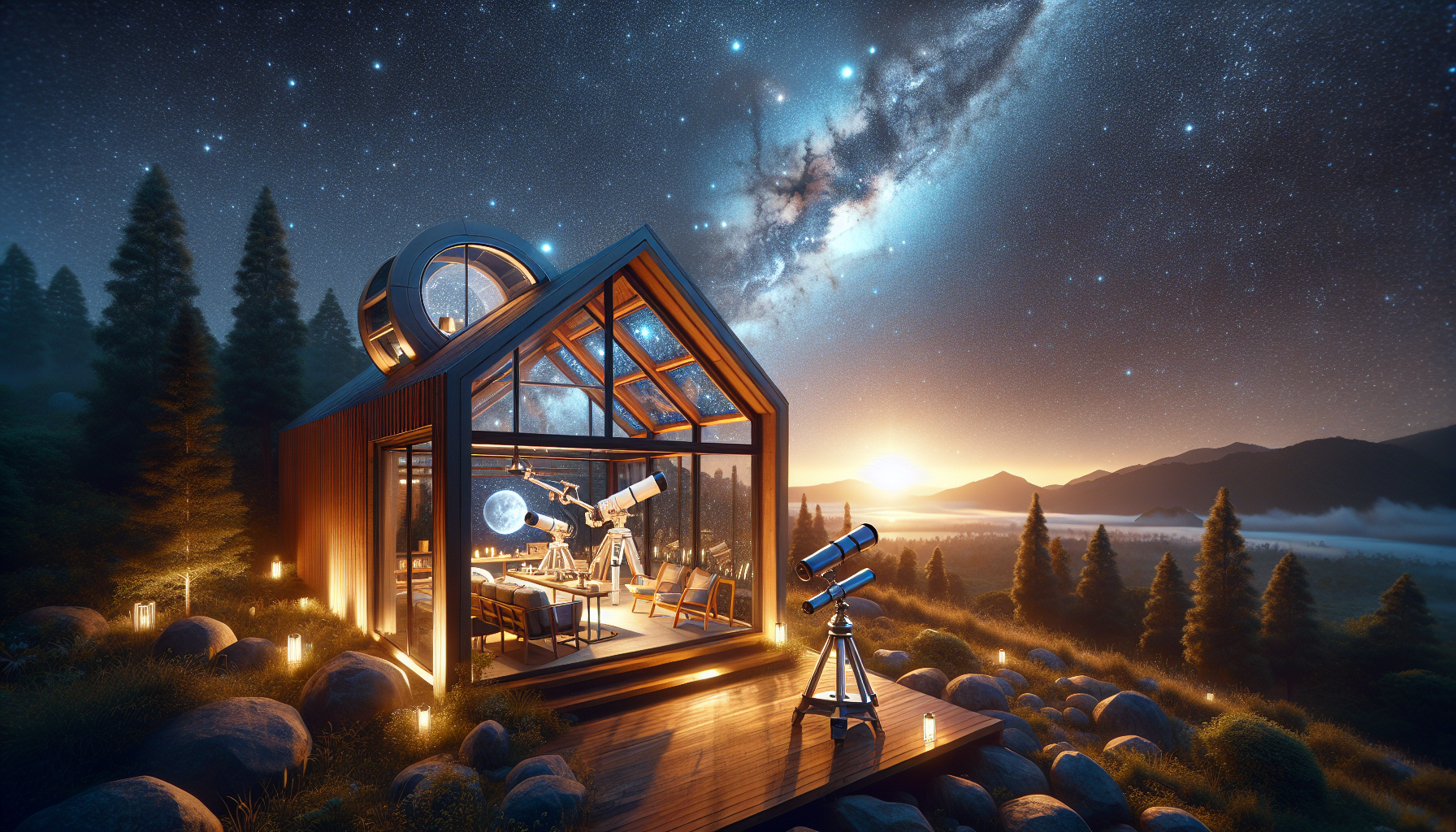In a world increasingly illuminated by the neon glow of cityscapes and the ceaseless flicker of digital screens, there remains a sanctuary of darkness, where the cosmos unveils its majestic tapestry in a spectacle that has captivated humanity for millennia. Welcome to the enchanting realm of stargazing sanctuaries, where celestial observation huts offer a window to the universe, reconnecting us with the wonders of the night sky. This journey will take you to places where the stars shine brighter, and the mysteries of the cosmos feel within reach—a refreshing escape into the serene beauty of the universe.
Imagine standing on a tranquil hilltop, far from the hustle and bustle of daily life, as the sun dips below the horizon and the first stars begin to twinkle into existence. The air is crisp, the surroundings serene, and above, the night sky stretches endlessly, a canvas of glittering gems scattered across the velvety blackness. These celestial observation huts are not just structures; they are gateways to the cosmos, carefully situated in remote locales where light pollution fades away, revealing the full grandeur of the universe. Here, the stars tell stories, the constellations dance across the sky, and the Milky Way unfurls its luminous band like a celestial river.
This article embarks on a journey to explore these magical sanctuaries, where architecture meets astronomy, and tranquility meets exploration. We’ll delve into the history of stargazing, tracing back to ancient civilizations who first turned their eyes upward, chronicling the stars as navigational guides and celestial deities. From there, we’ll venture into the present, highlighting some of the most renowned and remote stargazing huts across the globe. Whether perched atop a mountain, nestled in a desert expanse, or overlooking an oceanic horizon, each location offers a unique perspective on the heavens.
But these sanctuaries offer more than just a glimpse of the night sky; they provide a retreat from the frenetic pace of modern life, a chance to slow down and reflect. In an era where we’re constantly connected, these huts offer a rare opportunity to disconnect from the digital world and reconnect with the natural one. Here, under a canopy of stars, visitors can find peace and inspiration, their thoughts flowing as freely as the constellations above. It’s an invitation to embrace stillness, to ponder our place in the universe, and to rekindle a sense of wonder that often lies dormant in the day-to-day grind.
As we explore these stargazing sanctuaries, we’ll also uncover the best practices for celestial observation, from understanding the phases of the moon to identifying key constellations and planets. We’ll offer tips on what to bring, how to prepare, and the optimal times to visit for a truly unforgettable stargazing experience. So, whether you’re an avid astronomer or a casual skywatcher, ready your telescope and pack your sense of adventure, as we embark on this celestial journey. The stars await, and their story is one of awe, mystery, and infinite beauty. 🌌✨
The Allure of Stargazing Sanctuaries
In a world dominated by digital screens and artificial lights, the quiet, mysterious beauty of the night sky offers a respite like no other. Stargazing sanctuaries, which are specially designed huts or observatories for celestial observation, have become havens for astronomy enthusiasts and curious adventurers alike. These unique structures are often located in remote areas with minimal light pollution, providing an unobstructed view of the cosmos. The appeal of these sanctuaries lies not only in their ability to facilitate star observation but also in the serenity and connection to nature they offer.
The experience of stargazing in these sanctuaries is truly immersive. The isolation from urban noise and light allows for a deeper appreciation of the sky’s vastness and the universe’s endless mysteries. Many of these huts are equipped with telescopes and comfortable seating, inviting visitors to spend hours gazing upward in wonder. Whether you are an amateur astronomer or simply someone seeking a moment of peace, these sanctuaries provide a space where you can lose yourself in the cosmos.
Stargazing sanctuaries are more than just places to observe the stars; they are destinations that combine scientific curiosity with the simple joys of being in nature. They remind us of our place in the universe and the intricate dance of celestial bodies above. As you sit in a hut, surrounded by darkness and illuminated only by the glow of distant stars, it’s easy to forget the stresses of everyday life and embrace the magic of the night sky.
Design and Functionality of Celestial Observation Huts
Celestial observation huts are thoughtfully designed to enhance the stargazing experience. Their architecture often includes elements that prioritize both functionality and comfort. For instance, many huts feature retractable roofs or domes, allowing for a wide, unobstructed view of the sky. This design minimizes the impact of ambient light and maximizes the observer’s field of vision, ensuring that even faint celestial objects can be seen with clarity.
Inside these huts, you’ll typically find an array of amenities aimed at making your stargazing session as enjoyable as possible. High-quality telescopes, often mounted on adjustable stands, allow for easy navigation of the night sky. Comfortable seating or lounging areas are common, providing a relaxing environment for extended periods of observation. Some sanctuaries even offer heated interiors, ensuring that enthusiasts can enjoy the stars even on chilly nights.
Beyond their physical structure, these sanctuaries often integrate educational resources, such as star maps and informational panels, which guide visitors in identifying constellations and understanding astronomical phenomena. The combination of innovative design and educational tools makes these huts not just places to observe the stars, but immersive learning environments that deepen our understanding of the universe.
Comparative Analysis of Stargazing Locations
Choosing the right stargazing location can significantly enhance your experience. Factors such as geographical location, altitude, and climate all play crucial roles in determining the quality of your view. Below is a comparative table highlighting key characteristics of popular stargazing destinations around the world:
| Location | Light Pollution | Altitude | Best Season |
|---|---|---|---|
| Atacama Desert, Chile | Low | High | March – November |
| Mauna Kea, Hawaii | Very Low | Very High | Year-round |
| Jasper National Park, Canada | Low | Moderate | September – April |
Assista ao vídeo abaixo para uma visão mais profunda dos melhores locais de observação de estrelas:
Top Stargazing Destinations – National Geographic
Unique Features of Each Location
The Atacama Desert is renowned for its crystal-clear skies and minimal atmospheric interference, making it an ideal spot for both amateur and professional astronomers. Its high altitude and dry climate further enhance visibility, providing unparalleled views of the Milky Way and distant galaxies. Many celestial observation huts in this region are equipped with advanced telescopes, allowing visitors to explore the night sky in stunning detail.
Mauna Kea in Hawaii offers another exceptional stargazing experience. As one of the highest points in the Pacific, its elevation above the clouds ensures minimal light pollution and atmospheric distortion. The observatories atop Mauna Kea are some of the most advanced in the world, attracting astronomers from all over to study the stars and planets.
Jasper National Park in Canada is a designated Dark Sky Preserve, ensuring that light pollution is kept to a minimum. This pristine environment offers breathtaking views of the Northern Lights and other celestial phenomena. The park hosts annual stargazing festivals, drawing visitors eager to learn more about astronomy and experience the beauty of the night sky.
Embracing Technology in Stargazing
Technology has revolutionized the way we observe and understand the cosmos. From advanced telescopes to smartphone apps, stargazers today have access to a wealth of tools that enhance their experience and deepen their knowledge of the night sky. One of the most significant advancements in recent years has been the development of computerized telescopes. These devices can be programmed to track specific celestial objects, allowing users to effortlessly navigate the heavens with precision.
Smartphone apps have also become invaluable companions for amateur astronomers. These apps use augmented reality to overlay constellations and planetary paths onto the night sky, providing real-time guidance and educational insights. Some popular apps include Star Walk, SkySafari, and Stellarium, each offering unique features and capabilities to enhance your stargazing adventure.
In addition to these technological tools, many stargazing sanctuaries have embraced digital platforms to connect with a wider audience. Virtual stargazing sessions and online tutorials provide opportunities for people around the world to learn about astronomy from the comfort of their homes. These initiatives have made the wonders of the universe more accessible than ever before, inspiring a new generation of star enthusiasts.
- Computerized telescopes for easy navigation
- Smartphone apps for real-time sky mapping
- Virtual stargazing sessions and tutorials
The Role of Stargazing in Cultural and Scientific Contexts
Throughout history, stargazing has played a significant role in shaping human culture and advancing scientific knowledge. Ancient civilizations relied on the stars for navigation, timekeeping, and agricultural planning. The constellations were often associated with myths and legends, reflecting the cultural values and beliefs of different societies. Today, stargazing continues to inspire awe and wonder, driving scientific inquiry and exploration.
The study of celestial bodies has led to groundbreaking discoveries in astronomy and physics. Observations of the night sky have contributed to our understanding of planetary motion, the life cycle of stars, and the expansion of the universe. Stargazing sanctuaries play a crucial role in this ongoing quest for knowledge, providing a platform for both amateur and professional astronomers to conduct research and share their findings.
Moreover, stargazing fosters a sense of global community, as people from diverse backgrounds come together to explore the cosmos. Public stargazing events and festivals offer opportunities for cultural exchange and education, promoting a greater appreciation for the natural world and our place within it.
As you embark on your own stargazing journey, remember that each glance at the night sky connects you to a long tradition of exploration and discovery. Whether you’re peering through a telescope at a stargazing sanctuary or simply gazing upward from your backyard, you’re participating in a timeless pursuit that has captivated humanity for millennia.

Conclusion
Creating a sanctuary for stargazing is not just about building a physical structure; it is about cultivating a profound connection with the cosmos and enriching our understanding of the universe. Throughout this article, we have explored the concept of celestial observation huts, which serve as bridges between the earthly and the ethereal, allowing us to embark on extraordinary journeys under the vastness of the night sky.
We began by delving into the rich history of stargazing, tracing its roots back to ancient civilizations that looked to the stars for guidance and inspiration. From the monumental stone structures of Stonehenge to the intricate celestial maps of the Mayans, humans have long been fascinated by the mysteries of the heavens. This historical perspective not only highlights the timeless allure of stargazing but also emphasizes its significance in shaping human culture and knowledge.
Next, we explored the design and features of modern stargazing sanctuaries, emphasizing the importance of location, architecture, and technology in enhancing the celestial experience. These huts are strategically placed in remote areas with minimal light pollution, allowing for unobstructed views of the night sky. Their designs often incorporate eco-friendly materials and sustainable practices, blending seamlessly with the natural environment. Inside, state-of-the-art telescopes and digital tools empower enthusiasts to explore celestial phenomena with remarkable clarity and precision.
The article also discussed the growing trend of astrotourism, where travelers seek destinations that offer unparalleled stargazing opportunities. This emerging sector not only boosts local economies but also fosters a deeper appreciation for the natural world. By promoting responsible tourism and advocating for the protection of dark skies, stargazing sanctuaries play a crucial role in preserving these pristine environments for future generations.
Furthermore, we examined the educational and scientific value of these observatories. They serve as hubs for learning and discovery, where amateur astronomers and seasoned researchers alike can collaborate and share insights. Many sanctuaries offer workshops, guided tours, and lectures, making astronomy accessible to people of all ages and backgrounds. The data collected at these sites contribute to our understanding of cosmic phenomena, advancing the field of astronomy and inspiring new generations of scientists.
In reinforcing the importance of stargazing sanctuaries, we must consider the broader implications of celestial observation. In a world where technology often disconnects us from the natural world, these sanctuaries offer a space for reflection and contemplation. They remind us of our place in the universe and the intricate beauty of the cosmos. The awe-inspiring experience of witnessing a meteor shower or a distant galaxy through a telescope can spark a sense of wonder and curiosity that transcends cultural and geographical boundaries.
As we conclude this exploration of stargazing sanctuaries, I invite you, dear reader, to reflect on the magic of the night sky and the profound impact it can have on our lives. Whether you are a seasoned astronomer or a casual stargazer, consider visiting a celestial observation hut, where you can immerse yourself in the beauty and mystery of the universe. Share your experiences and insights with others, inspiring them to look up and explore the wonders above.
Let’s continue to protect and cherish these sanctuaries, ensuring that future generations can also experience the magic of stargazing. By promoting awareness and advocating for the preservation of dark skies, we can contribute to a global movement that values the beauty and significance of the night sky.
I encourage you to leave a comment below sharing your thoughts and experiences with stargazing. Have you visited a stargazing sanctuary? What celestial phenomena have left you in awe? Your stories can inspire others to embark on their own celestial journeys. Additionally, consider sharing this article with friends and family who may be interested in discovering the magic of stargazing sanctuaries. Together, we can foster a community of enthusiasts who appreciate the wonder of the night sky.
For further exploration, I recommend visiting resources such as the International Dark-Sky Association (https://www.darksky.org), which offers valuable information on dark sky preservation and astrotourism destinations. Additionally, the Royal Astronomical Society (https://ras.ac.uk) provides insights into astronomical research and events worldwide.
In closing, let us embrace the timeless allure of stargazing and the sanctuaries that facilitate this extraordinary experience. May the night sky continue to inspire wonder, curiosity, and a deeper connection with the cosmos for all who venture beneath its canopy. 🌌✨
Toni Santos is a visual storyteller and cosmic interpreter whose work illuminates the ancient skywatchers and their prehistoric astronomy—the profound ways early humans observed and revered the heavens before written history. Through a visionary lens, Toni explores how the stars, planets, and celestial cycles shaped myth, ritual, and survival in cultures lost to time.
Rooted in a fascination with archaic observatories, stone alignments, and celestial symbolism, Toni’s creative journey reveals the deep human impulse to understand and harmonize with the cosmos. From lunar phases guiding planting seasons to the sacred paths of the Milky Way, each of his works embodies the awe and knowledge encoded in the night sky.
Combining artistic craftsmanship with archaeological insight, Toni’s pieces evoke the mystery and precision of prehistoric astronomers. His work does more than depict—it channels the timeless dance between earth and sky, bridging ancient wisdom with contemporary wonder.
As the visionary behind Vizovex, Toni shares curated visuals, essays, and symbolic studies that invite others to reconnect with the cosmic heritage written in stone and starlight. His creations are a call to look upward, to listen to the silent stories told by the stars, and to honor the first astronomers who mapped the heavens with reverence and ingenuity.
His work is a tribute to:
The celestial wisdom of prehistoric peoples
The sacred geometry of ancient observatories
The enduring bond between human culture and the cosmos
Whether you’re a stargazer, a scholar of ancient mysteries, or someone captivated by the universe’s earliest storytellers, Toni welcomes you to journey through a space where the sky is both map and myth—one constellation, one ritual, one revelation at a time.




